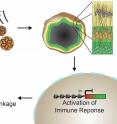Evidence that Zika causes neural stem cells to self-destruct
A new addition in the growing number of studies using brain organoids to understand how the Zika virus leads to microcephaly reveals that human neural stem cells infected by the virus subsequently trigger an innate immune response that leads to cell death. On May 6 in Cell Stem Cell, University of California San Diego School of Medicine researchers report that if this immune response is blocked, it helps neural stem cells survive Zika infection. Zika contributes to cell self-destruction by activating an infected brain cell's innate immune receptor TLR3, which has long been known to coax cells into producing antiviral proteins as a first line of defense against microbial invaders. Graduate student Jason Dang, whose research interest is in how TLR3 responds to different viruses, stumbled upon this connection when he decided to test TLR3 levels in Zika-infected brain organoids developed in the lab of Tariq Rana at UC San Diego's Biomedical Sciences Graduate Program.
"We were wondering how strong the evidence was, and we were excited when we saw that when we inhibit TLR3 in the Zika-infected brain organoids, the reduction in their size was less dramatic," says Rana, a professor of pediatrics and senior author on the paper. "I was still not convinced, so we used a chemical to enhance TLR3 activation and observed that the brain tissue started to shrink a lot faster."
Previous work in Zika-infected brain organoids helped establish the connection between viral infection and the death of neural stem cells, but Rana's team adds in a new piece about the role of the immune system. Inhibition of TLR3 may help neurons infected by Zika survive and continue to function as well as their uninfected counterparts, thus providing a target for therapeutic development.
"A part of my lab works on other viruses and we always look at macrophages and other external immune cells--we never would have thought to look at this system," Rana says. "There are many other viruses that cause central nervous system damage, and now I want to go back and look at those as well."
Source: Cell Press
Articles on the same topic
- Zika virus may cause microcephaly by hijacking human immune moleculeFri, 6 May 2016, 18:07:49 UTC
- New Zika mouse model accumulates virus in the brain and other tissuesFri, 6 May 2016, 18:06:50 UTC
Other sources
- Zika virus may cause microcephaly by hijacking human immune moleculefrom Science DailyFri, 6 May 2016, 18:01:12 UTC
- Zika destroys fetal brain cells, lab study findsfrom UPIFri, 6 May 2016, 16:30:56 UTC
- Study strengthens suspected link between Zika and paralysisfrom AP HealthThu, 5 May 2016, 21:10:45 UTC
- Zika virus and health systems in Brazil: From unknown to a menacefrom Science DailyTue, 3 May 2016, 21:00:46 UTC

